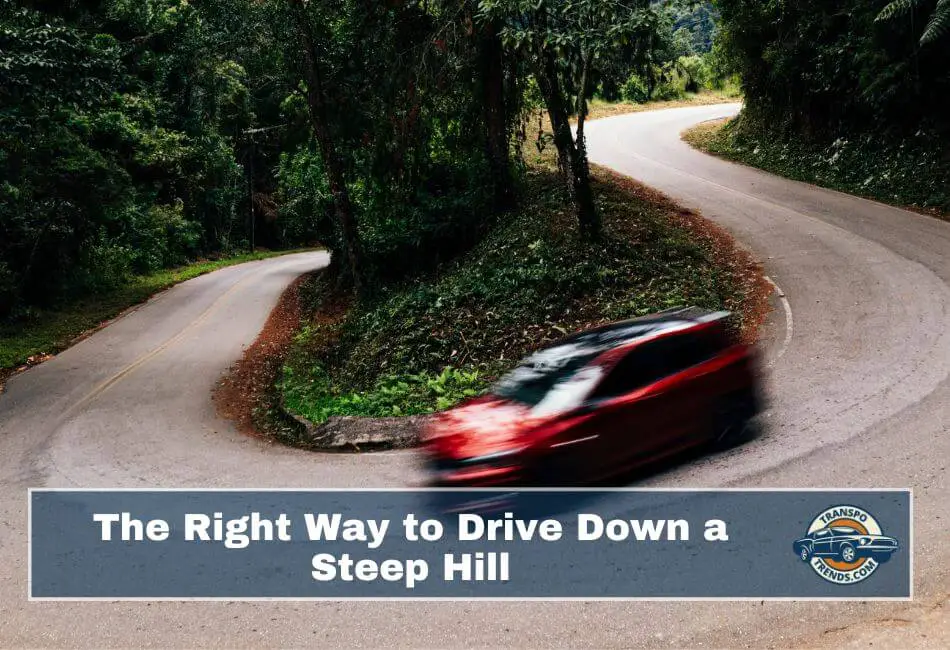You’re heading down a long, winding hill. The view is great, the air is fresh… and then it hits you — the car is picking up speed faster than you expected. Your instinct? Slam the brakes or coast to “save gas.”
Here’s the truth: almost everyone does the wrong thing on long descents. And it’s not just a minor mistake — it’s the kind of bad habit that can cost you your brakes and your control.
This guide breaks down exactly why the common methods are dangerous and what you should be doing instead to keep your speed, your brakes, and your nerves in check.
Mistake #1 – Coasting in Neutral
Some drivers swear by it: “Throw it in neutral and let gravity do the work.” It sounds like it would save fuel and be gentle on the engine, but in reality? It’s a safety nightmare.
When you’re in neutral, the engine isn’t connected to the wheels. That means you’ve got zero engine braking — the natural resistance that happens when the engine slows the wheels down.
Without that resistance, the car is basically a runaway sled. Even on a slight slope, you’ll start gaining speed quickly.
With no gear engaged, your only way to slow down is the brake pedal. And that’s where things get scary. Constant braking builds up heat — a lot of it. Pads and rotors can get so hot that the brakes start to fade (lose stopping power).
Push it too far, and you could have complete brake failure.
There’s another problem: if a hazard appears, you can’t instantly accelerate to dodge it. You have to re-engage a gear first, which wastes precious seconds.
Oh, and about the fuel savings? Modern fuel-injected engines already use little to no fuel when you take your foot off the gas while in gear. Coasting in neutral doesn’t save you fuel — it just removes one of your most important safety tools.
Mistake #2 – Riding the Brakes
The other common approach is to leave the car in Drive or a high gear and keep a light, constant pressure on the brakes the whole way down. It feels controlled… at first.
But brakes work by turning motion into heat. On a long hill, that heat builds fast. If the pads, rotors, or brake fluid get too hot, your brakes will fade — or in extreme cases, fail completely.
You might notice a burning smell, a soft pedal, or the need to press much harder to slow down. All signs of brakes that are dangerously overheated.
Overheated brakes don’t just lose stopping power — they can glaze over, warp rotors, and cost you.
The lesson: your brakes aren’t designed to do all the work on a long hill. You need another way to keep speed under control.
The Right Way – Engine Braking
Here’s the fix: use engine braking. This is when you use a lower gear so the engine itself helps slow the car down. It’s simple, it’s safe, and it’s exactly what your transmission is built for.
- For Automatics
Most automatic cars have a gear marked “L” (low) or numbers like “1” and “2.” These prevent the transmission from shifting into higher gears, keeping the engine revving higher so it resists the car’s motion.
Before you start down the hill, slow to a safe speed and shift into L or 2. You’ll hear the engine rev higher — that’s normal.
The extra resistance is your friend. Now the engine is doing most of the braking, and you can use the foot brake only when needed.
On the descent, use intermittent braking: press the brakes firmly for a second or two to reduce speed, then release. This gives the brakes time to cool between uses.
Some modern cars also have “hill descent control” or a “B” mode (in hybrids and EVs) that boosts engine or regenerative braking. If your car has these, use them.
- For Manuals
If you drive a stick shift, you’ve got even more control. Before starting down, shift into a lower gear — usually 2nd for steep hills, 3rd for moderate slopes. Keep the clutch engaged so the engine is connected to the wheels.
Like automatics, you can add short bursts of braking if needed, but the engine should be doing most of the work.
Avoid dropping from a very high gear straight to a very low one at speed — downshift one gear at a time to keep things smooth and safe.
A good rule: go down in the same gear you’d use to go up the hill.
Why Engine Braking Works
When you downshift, the engine spins faster without extra fuel being burned. That spinning resists the rotation of the wheels, acting like a brake.
It spreads the work of slowing the car between the brakes and the drivetrain, meaning your brakes stay cooler and ready for emergencies.
Unlike coasting in neutral or riding the brakes, engine braking keeps you in full control. You’re ready to slow, steer, or accelerate at any moment.
Step-by-Step: Safe Descent Technique
- Scan Ahead – Spot the hill early so you have time to prepare.
- Reduce Speed Before the Slope – Don’t wait until you’re halfway down to slow down.
- Shift to a Lower Gear – L or 2 for automatics, 2nd or 3rd for manuals.
- Let the Engine Hold You – Take your foot off the gas and feel the car slow naturally.
- Use Brakes in Short Bursts – Only when extra slowing is needed.
- Stay Alert for Hazards – Keep both hands on the wheel, eyes scanning for curves, vehicles, or debris.
- Shift Back Up on Level Ground – Once the road flattens, return to normal gearing.
The Big Myths — Busted
Myth: Coasting saves fuel.
Truth: Modern engines cut fuel on deceleration in gear. Coasting in neutral uses more fuel than engine braking.
Myth: Engine braking damages the transmission.
Truth: When used correctly, engine braking is safe and built into the design of your car. It’s not the same as over-revving.
Myth: Brakes are enough if you’re careful.
Truth: Even light braking over a long hill can overheat and fade your brakes.
What Happens If You Ignore This Advice
Let’s be real — most drivers won’t notice a problem until it’s too late. But here’s what can happen if you rely on bad downhill techniques:
- Brake fade – The pedal feels soft, and stopping distances get longer.
- Complete brake failure – The pedal sinks to the floor with no effect.
- Warped rotors – Causes vibration and costly repairs.
- Loss of control – Especially dangerous on curves or with oncoming traffic.
- Runaway vehicle – A terrifying and often deadly outcome.
Extra Tips for Everyday Drivers
- Don’t overload your car – Extra weight means more momentum and more strain on brakes.
- Check your brakes regularly – Worn pads or old brake fluid make overheating more likely.
- Know your route – If you’re heading into mountain country, be ready before you see the first steep descent.
- Use engine braking in bad weather – On wet or icy roads, it reduces the risk of skidding compared to heavy braking.
Bottom Line
Long downhill stretches are where driving mistakes turn dangerous fast. The fix isn’t complicated — keep it in gear, use the engine to slow you down, and treat your brakes like a backup, not the main act.
It’s a small change in driving habit, but it can save your brakes, your control, and maybe your life. Next time you see that steep grade sign, downshift, take it slow, and let your car’s engineering work for you.
Summary: Do’s and Don’ts for Steep Hills
| Don’t | Why | Do Instead |
|---|---|---|
| Coast in Neutral | No engine braking, loss of control, brake overheating | Stay in gear and use low range |
| Ride the Brakes | Overheats brakes, causes fade or failure | Brake in short bursts while engine braking |
| Start Too Fast | Harder to slow down safely | Slow down before the hill |
| Late Downshifting | Misses the benefit of engine braking | Shift early and let the engine hold speed |

